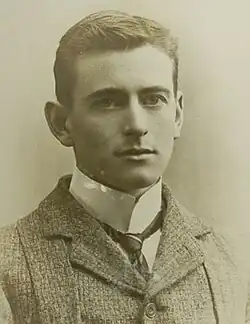Andrea Angel
Andrea Angel | |
|---|---|
 Portrait photograph of Angel | |
| Born | 9 January 1877 Bradford, Yorkshire, England |
| Died | 19 January 1917 (aged 40) Silvertown, London, England |
| Cause of death | Silvertown explosion |
| Alma mater | Christ Church, Oxford |
| Spouse | Mary Letitia Stock (1904) |
| Children | 2, including Heather |
| Awards | Edward Medal |
| Scientific career | |
| Fields | Chemistry |
| Institutions | Brasenose College, Oxford Keble College, Oxford Christ Church, Oxford |
Andrea Angel (1877–1917) was a British chemist who died accidentally in the Silvertown explosion.[1]
Life
Andrea Angel was born on 9 January 1877 in Bradford, Yorkshire, England.[2] His father was Thomas Angel, a tax supervisor, and his mother was Angelina. He attended Exeter School and then won an exhibition (scholarship) to study chemistry at Christ Church, Oxford,[3] gaining a first-class degree in 1899. Subsequently, he became a lecturer in Oxford at Brasenose College, Keble College, and then Christ Church, running the chemistry laboratory there.[1]
At the start of World War I in 1914, Angel wished to join the army, but with his chemistry expertise applicable to the manufacture of munitions, he was not allowed to enlist. Instead, he joined the Brunner Mond Company to help with work for the Ministry of Munitions. In 1915, he was appointed Chief Chemist and oversaw the purification of the explosive TNT in a former caustic soda factory at Silvertown, East London. A fire started in the evening of 19 January 1917.[4] George Wenborne notified Angel, who urged the factory workers to flee for safety while he, with others, tried to extinguish the fire. However, after only a few minutes, there was a very large explosion involving around 53 tons of TNT. Angel was killed, along with 72 others. 94 people received serious injuries. It was the largest single explosion experienced in London.[1]
.jpg)
In 1904, Angel married Mary Letitia Stock in Headington, Oxford, and they had two daughters, the youngest of whom was an actress.[3] From 1905 to 1917, they lived at Park Villas, at the south end of Banbury Road, Oxford. Initially, they were at no. 17 (1905–1912), and later at no. 15 (1912–1917), where a blue plaque was added on 14 July 2018.[4] These buildings are now used by the IT Services of the University of Oxford.
Legacy
Andrea Angel and George Wenborne were posthumously awarded the Edward Medal (First Class), the highest civilian bravery honour (later the George Cross). Angel was also awarded a Carnegie Hero Fund Trust medal, an award started in 1908 in the United Kingdom for the recognition of civilian heroism.
In 2016, during its 175th anniversary, the Royal Society of Chemistry chose Angel as one of the 175 Faces of Chemistry.[1]
Bibliography
- M. C. Grossel, A Hero of the Home Front (2016)
- Graham Hill & Howard Bloch, The Silvertown Explosion, London 1917 (2003)
References
- ^ a b c d "Andrea ANGEL (1877–1917): Oxford Chemist, Home Front Hero – 15 Banbury Road, Oxford". UK: Oxfordshire Blue Plaques Board. 2018. Retrieved 7 August 2025.
- ^ "Dr Andrea Angel EM". victoriacrossonline.co.uk. UK. Retrieved 7 August 2025.
- ^ a b "Andrea Angel". UK: Christ Church, Oxford. Retrieved 7 August 2025.
- ^ a b "Heroism of Oxford chemist killed in wartime factory explosion". Oxford Mail. UK. 13 July 2018.
External links
- Andrea Angel life from the Imperial War Museum